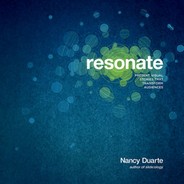
Laughter
What could be
0:02 0:04 0:06 0:08
What is
0:00 0:10
Story
Piano
Speaking
S.T.A.R. Moment
50 Resonate
Establish What Is
After hooking the
audience with a story,
Zander states, “There
are some people who
think that classical
music is dying.”
Teach Them to Listen
Zander teaches the audience how
to listen for “impulses” in the music
and challenges the audience to
listen for them in his playing. He
educates them about music theory
and performance.
Engage by Singing
When he describes the Chopin prelude,
he plays descending notes of a scale—B,
A, G, F
#
—then withholds the last note
(E) and invites the audience to sing it.
They’re reluctant at first, so he repeats
his request. When the audience sings
the final note, he remarks, “Oh, the TED
choir!” eliciting laughter.
Establish What Could Be
Zander is passionate about showing the
audience how to love classical music. He says,
“It doesn’t work for me to [have] a wide gulf
between those who understand, love, and
are passionate about classical music, and
those who have no relationship to it at all…I’m
not going to go until every single person in
this room…come[s] to love and understand
classical music.”
Zander’s Sparkline
CH002.indd 50CH002.indd 50 8/16/10 9:01:27 AM8/16/10 9:01:27 AM

0:12 0:14 0:16 0:18 0:20
Lessons from Myths and Movies 51
Engage by Singing
Though not shown in the video, Zander comes
back for an encore in which he leads the “TED
choir” in a rousing rendition of Beethoven’s
Ode
to Joy
in German.
Call to Action
Zander concludes by sharing a life-changing
realization that his job is to awaken the
possibility in others. “And do you know how to
find out [if you succeeded]? You look at their
eyes. If their eyes are shining, you know you’re
doing it.” He challenges the audience to ask the
question of themselves: “Who are we being as we
go back into the world? It’s not about wealth and
fame and power. It’s about how many shining
eyes are around you.”
Emotional Contrast
Zander taught the audience how a chord pulls the music toward the
home key like a magnet. As the music moves away from home into
other chords, the music feels persistently unresolved. As the music
persists in long, unresolved chords, it creates a sense of longing until
it finally comes back to the home key. The music wants to resolve
and go home. Then he says, “Would you think of somebody who
you adore who is no longer there—a beloved grandmother, a lover,
somebody in your life who you love with all your heart but that
person is no longer with you. Bring that person into your mind and
at the same time follow the line all the way from B to E, and you’ll
hear everything that Chopin had to say.”
This time when he plays the piece, the beauty of
longing and desire that was built into the piece
manifests itself in the hearts of the audience. They
can feel themselves in the music. People in the
audience fall in love with classical music when they
can understand it emotionally.
CH002.indd 51CH002.indd 51 8/16/10 9:01:28 AM8/16/10 9:01:28 AM
52 Resonate
Stories have been told for thousands of years in order to transfer cultural
lore and values. When a great story is told, we lean forward, and our
hearts race as the story unfolds. Can that same power be leveraged for
a presentation? Yes.
The timeless structure of a story can contain information that persuades,
entertains, and informs. Story serves as a perfect device to help an audi-
ence recall the main point and be moved to action. Once a presentation is
put into a story form, it has structure, creates an imbalance the audience
wants to see resolved, and identifies a clear gap that the audience can fill.
CH002.indd 52CH002.indd 52 8/16/10 9:01:28 AM8/16/10 9:01:28 AM
..................Content has been hidden....................
You can't read the all page of ebook, please click here login for view all page.
